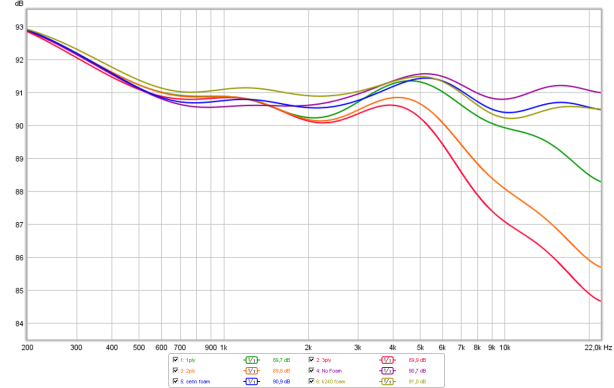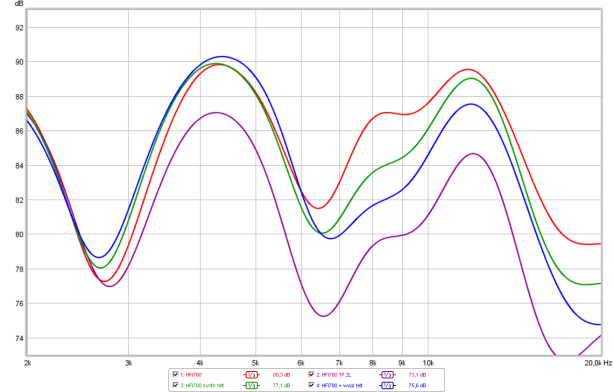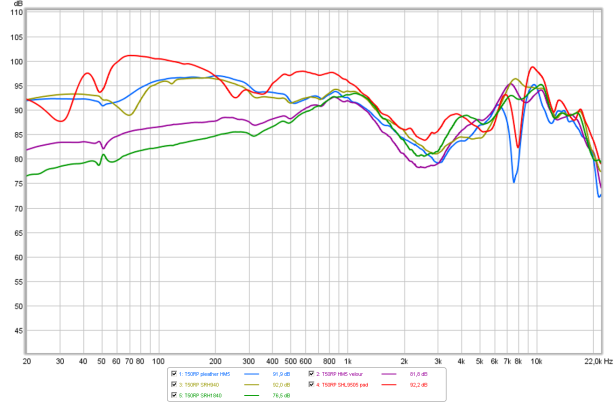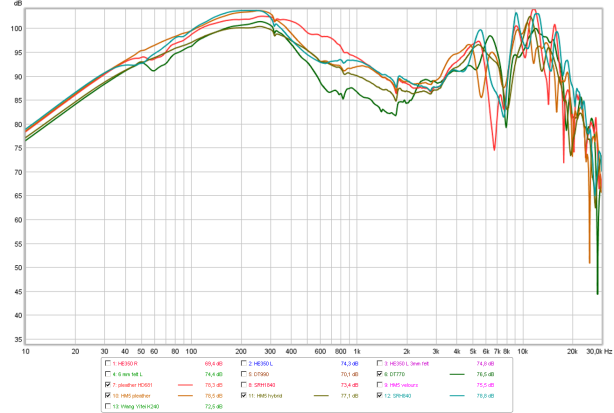taming the treble
published: Jul-27-2016, last edit: Mar-18-2021
A lot of headphones are troubled by a peak (or even more peaks) or have an elevated treble area.
Usually between 6kHz and 10kHz which, when the peak is wide and high enough, can cause sibilance (sharp ‘sss’ sounds) or make it sound ‘overly detailed’.
There are a few ways these treble peaks can be lowered. In some cases not only the peak is lowered but frequencies around the problem area may also be affected.
4 ways to tame the treble.
- use (parametric) EQ often is the cheapest way to go when in the digital domain.
- adding damping materials in front of the driver can be another fairly cheap solution.
- changing pads can be costly and often affects more than the treble.
- use passive filtering is a more targeted way similar to simple one-band PEQ but in the analog domain.
Most digital devices, be them a smart-phone, tablet, laptop or modern Digital Audio Players have some kind of equalizer available included on the device or apps for this can be downloaded. Some even for free.
There are 2 practical equalizers that are quite common. The graphic equalizer that has a number of sliders in various frequency bands (with a fixed frequency and bandwidth). Those sliders can boost or lower frequencies in their respective bands.
The ones with just 4 to 6 bands are more of a tone control than a device that can be used to correct headphones.
At least 10 but preferably more bands are needed for correcting headphones.
There are websites that have measured (or use measurements) that have already figured out where to set the sliders for certain graphic equalizers so you can improve tonality of headphones. This is not just limited to treble frequencies.
Analog graphic equalizers also exist but aren’t cheap. Those that are cheaper usually have a rather high amount of noise.
Then there is the more useful PEQ or Paramatric EQualizer. This is too is nearly always digital. Analog devices do exist but are very expensive in general and the more modern ones work by converting analog to digital, process digitally and convert back to analog.
A cheaper and somewhat decent device with a lot more of digital trickery is the Behringer DEQ2496.
The advantage of parametric EQ over graphic EQ is that a number of bands can be set to specific frequencies. The ‘width’ of each band can be set between very wide to very narrow. That flexibility is the parametric part. One can set the parameters of each filter section. Each section can be set to boost or lower that frequency band. Also one can also, aside from having frequency bands, set an entire lower or upper part of the frequency range to be boosted or lowered. This is called a shelf filter.
For this type of EQ there also are websites which have figured out how to set the filters so that the tonal balance can be adjusted exactly* (*well this is debatable) so a headphone (or speakers) can be tonally corrected.
For both types of EQ in the digital domain there is a penalty. The penalty is caused by the fact that most recordings have peaks close to the maximum level (0dBFS) 0 dB Full Scale.
In most cases people want to boost certain areas. Mostly lower bass or mids. This would mean the digital signal could ‘clip’. A signal cannot be higher than 0dBFS which could occur when boosting frequencies. For this reason one should use ‘pre-amp gain’.
This basically is a volume control which lowers the overall signal BEFORE the EQ boost is created.
When one has boosted bass by say +5dB then the pre-amp should be set to -5dB (preferably even slightly lower) so that before EQ the peaks are reaching max -5dBFS. This way one can apply the bass boost without clipping the digital signal.
This means when using digital EQ (to boost, not when one only lowers frequencies) the penalty is loudness is lower.
In short:
Digital EQ is cheap or even free but requires the digital domain to be cheap.
For correcting headphones you need either >10 band graphic EQ or a least a few bands PEQ.
Penalty could be a lower output volume.
Analog EQ is anything but cheap. A lot of the modern ‘analog EQ’ devices use ADC and DAC conversion and processing is done digitally.
For people devoted to vinyl and tape that don’t want anything to do with digital only all analog EQ is an option.
The Kameleon is a DIY all analog headphone amplifier EQ that does not inject a lot of noise but can only correct certain headphones.
Each headphone needs a separate ‘module’ which basically is a very basic PEQ device but all analog and limited in what it can do.
Another way of taming the treble is by adding damping/filter materials in front of the driver. These materials may consist of foam, felt (synthetic or wool based), cloth or paper.
In some cases felt like materials may work well, in other cases (toilet)paper or foam may work well.
One should realise that the amplitude of treble signals is much smaller than those of lower frequencies (bass) and that all those sound waves that one does not want changed must be able to pass the filter material without being affected.
Different materials have different effects in different frequency bands and in different amounts of treble attenuation. Driver size may even also play a role here.
In some cases adding paper in front of a driver drastically lowers a peak and in other cases the peak may just become slightly lower. It is hard to predict what effect what material has what kind of effect on each headphone/driver.
Just ‘listening’ (what most modders do) for changes may help with determining what material does what exactly. Measuring the differences is obviously better though.
A different seal, a different song, a different listening level and above all a slightly different position on the head may skew the results.
To give an idea of the frequency section and amount of damping various materials have on a well damped driver below some plots of the HD650 driver.
The plots are smoothed over a complete octave so the general effect of each material becomes more obvious. Note that the vertical scale is 1dB/div for this plot.

No materials in front of the driver, Sennheiser foam, AKG K240 foam, 1 ply of toilet paper, 2 plies of toilet paper, 3 plies of toilet paper.
As can be seen the influence of foam in front of the driver is small, generally < 1dB.
1 ply of toilet paper shows effects >10kHz. 2 plies and 3 plies start to have an effect >3kHz.
For headphones that do have a peaks (the HD650 does not) but the Ultrasone HFI780 does. Note that the vertical scale here is 2dB/division. The larger scale was needed because of the amplitude swing.
To show the peaky behaviour better smoothing is smaller… 1/3 octave smoothing.

Stock HFI780 driver, 2mm thick synthetic felt in front of the driver, 3mm wool felt and 2 layers of toilet paper.
The felt seems to have a few dB of influence above 6kHz. The toilet paper already shows to have influence > 3 kHz and is a lot more effective in lower the amount of treble.
This is similar to the effect shown in the HD650 which also shows some effect above 3kHz.
When attenuation is needed above 3kHz toilet paper seems the way to go. The amount of toilet paper layers determines how much attenuation there is and from which part of the frequency band upwards.
Needless to say that when one only wants to lower the upper mids/lower treble part and not the treble and upper treble these materials can not be used as these materials do not act as band filters but can only attenuate above a certain frequency band and attenuation will increase when the frequency gets higher.
This is also visible in the experiments below on the Superlux HD662-EVO where different materials are used in front of the driver in order to lower the treble peak.
Here too 1/3 octave smoothing and 2dB/ division is used.

Nothing in front of the driver, Stock foam, 2mm thick synthetic felt, paper kitchen towel, paper handkerchief and coffee filter.
As can be seen the 2mm synthetic felt reduces the 9kHz peak by 2dB where the foam does very little (<1dB).
There isn’t much difference between (2 plies) of handkerchief and paper towel either. This is very similar to 2 plies of toilet paper (not shown)
As there are quite some different types of toilet paper it should be made clear that the toilet paper used here is not the 1-ply type but the softer 4-ply toilet paper where the individual plies of paper were pulled apart to single thin pieces of paper. The same can be done with paper kitchen towels and paper handkerchiefs.
I don’t think the brand of toilet paper will have much influence on the effect though.
The coffee filter is made of much thicker and denser paper and has a substantially larger effect.
Where the paper plies show a reduction of the 9kHz peak by about 5dB the coffee filter shows a reduction 0f 10dB but also rolls of the upper treble too much.
Below a plot of the Beyerdynamic DT150 fitted with HM5 pads. 1 ply toilet paper, 2 plies toilet paper. scale is 5dB/div and no smoothing is used. The toilet paper starts to work above 5kHz (2 plies) and 6kHz for 1 ply and appears less effective above 16kHz again.
For this particular headphone 1 ply of toilet paper effectively lowers the 11kHz treble peak by a good 7dB while not affecting treble extension at all.

sometimes felt can also have some substantial effects. In the plot below this is shown for the AKG K612 where 3mm thick woolfelt lowered the treble peaks by 7dB.

Below some experiments with an old Beyerdynamic DT990-600 where the same 3mm woolfelt has a somewhat less profound effect. (5dB/div, no smoothing)

Below the Superlux HD681-EVO where the 3mm thick felt disc in front of the driver was removed. With 3mm felt disc, without felt disc. For this headphone the felt starts do something above 5kHz but as the frequencies get higher the damping also increases making the headphone roll-off its treble sooner. (5dB/div, no smoothing)

Below some experiments with the AKG K551. Most K550 and K551 are notorious for having a treble peak that is bothersome for some. Here 2mm thick medical felt is used.
5dB/div, no smoothing. The felt shaved a good 5dB of the treble peak while not affecting the rest that much.

in short:
Treble peaks can be lowered by using certain kinds of damping materials in front of the drivers. An advantage is that the materials used are cheap, easy to insert in front of the driver. Are reversible (can be taken out again) and it is easy to experiment with.
A downside is that it not only affects the problem areas one wants to address but often also frequencies above the peak which is not always desirable.
Also the usage is limited and only works for higher frequencies.
Changing pads sometimes can help with lowering peaks in the treble. Usually at the cost of other frequency (bands) though.
Should you want to change pads because of comfort issues or because someone said a headphone sounds MUCH better when pad A or B is used then you should realise that it is possible bass or mids are much more affected than the treble part is.
To show this below some plots of exactly the same driver (Beyerdynamic DT150) set at the exact same volume control position with various pads on it. DT150 pleather pads, DT100 velours pads, HM5 pleather pads, HM5 velours pads, Angled HM5 pleather pads, angled velours HM5 pads, HM5 hybrid pads (pleather, perforated pleather on the inside and velours on the ‘skin’ side)

As can be seen there certainly is an influence in the treble part (>4kHz) but bigger differences are found in lower parts of the frequency range.
Below some plots of the exact same driver (Fostex T50RP) with different pads as only variable. The vertical scale is 5dB/div, no smoothing applied.
pleather HM5, Velours HM5, velours SRH940, velours SRH1840, pleather SHL9505 pad

Here too bigger differences can be found below 1kHz than above it.
Below the Superlux HD681 (with a passive notch filter used) with various pads.
The vertical scale is 2dB/div and the plots are 1/3 octave smoothed so small ‘wiggles’ don’t clutter the whole picture.
velours AKG K240 pads, pleather T50RP pads, pleather SRH840 pads, velours Superlux pads, original pleather Superlux pads, Chinese velours pads, velours SRH940 pads.

In some cases the differences between original brand velours and pleather pads can be VERY big, as in the Philips A5Pro below, official pleather pads, official velours pads

Sometimes the differences between original pads may be small as in the HD662-EVO shown below. original pleather pads, original velours pads. As can be seen hardly any difference in the treble part, only a few dB difference in the amount of bass.

So when changing pads to get rid of (nasty) treble you should be aware that, more often than not, you change other parts of the frequency range as well.
Using different pads may sometimes lead to improved sound quality but in other cases might screw up the frequency response / tonal balance.
Below the plots of several pads which screw up the frequency response of the HIFIMAN HE-350 considerably.
Pleather HD681-EVO pads, DT770 pads, HM5 pleather pads, HM5 hybrid pads, SRH840 pads. The pleather HIFIMAN pads act similar to the HM5 pleather pads.

As can be seen the treble peak is not affected much and all these pads will give it a massive ‘hollow/honky’ sound.
Below some pads that could be used with this headphone (HE-350).

HE350 pad, DT990 pad, HM5 velours pad, SRH1840 pad, Chinese K240 pad.
The velours HM5 pad is the most interesting one here as it increases the bass response and warms up the sound. Around 150Hz the level is about the same as the 5kHz treble peak. This effectively lowers the treble peak and warms up the sound. Because of this the sharp treble is less obvious and the sound is a bit more like the DT990.
In some cases, like the HE350 below, felt/toilet paper doesn’t work that well. Stock, 3mm felt, 6mm felt.
The peak is lowered slightly but treble extension is compromised and the headphone becomes boring and life-less in the highs.

In some case toilet paper or felt reduces the amout of upper treble too much. This is where a (parametric) Equalizer comes in handy.
EQ can be applied by using a digital or analog equalizer. In the digital world it is easier to make all kinds of filter types. Filters with adjustable bandwidths (Q) and accurate frequency bands as well as amplitude levels, shelving filters and other kinds are easy to apply but need processing power (PC, Laptop, Tablet, DAP or mobile phone).
Very complex filters can be created with lots of different band and shelving filters.
In my experience the more complicated the filter is the more ‘damaging’ it may be to the overall sound quality even though the tonal balance may have improved.
Complicated EQ in the analog domain takes lots of electronics which usually adds noise and is quite expensive and bulky to make.
In my experience the best results can be obtained by only applying some simple EQ to the actual ‘problem area(s)’ of the headphone with simple analog filters. This way the music istelf remains ‘bit perfect’ no processing power and digital manipulation and attenuation is needed.
For this the Kameleon filter/amplifier is a gadget that can pull this off.
Shown below the HiFiMan HE-400i. It has a narrow but audible peak at 8kHz of +8dB.
Some people aren’t bothered by it and feel it makes the headphone more detailed.
To others the peak is nothing but fake detail and brings an annoying ‘edge’ to certain instruments.
In this case 1ply of toilet paper didn’t do much at 8kHz and 2 plies lowered the treble itself too much already (alas not saved). Stock HE400i driver, 2mm felt in front of the driver.
In this case some (parametric) EQ can do more. As can be seen the 8kHz is completely removed and treble extension is improved.

Below an example of simple EQ (a wide notch filter) that helps remove the excess treble in a Beyerdynamic DT990. Of course, to some, the elevated treble of the DT990 is seen as a strong point which gives an almost ethereal treble with a seemingly very high amount of detail. To others the treble is way too much and sibilance and headaches are lurking here.
2dB/div and 1/3 octave smoothing is applied.


Another way of applying relatively ‘simple’ EQ is by building a passive filter that is placed in line with the headphone cable.
A disadvantage of the EQ below is that it is hard to make for headphones with impedances > 60Ω and that they need to be calculated and or simulated. There is no way of creating some ‘standard’ filter configurations one can choose from.
A filter like this is somewhat complicated and requires electronic knowledge to implement and build. Below the schematic for this filter.

The plot below is from a stock Superlux HD681 and with a passive filter built-in the headphone cable, or in this case, in the actual headphone cups themselves.

An attenuation of 8dB in the ‘problem area’ only is possible. As there is nothing in front of the driver nothing of the sound waves is obstructed in any way.
Not all headphones can easily be fixed this way though.
Also headphones like the Beyedynamic DT1990 and HD800 are notorious for their treble peak. For most people this is the only real downside and are otherwise happy with the sound.
Below the effect of a passive filter used with the DT1990

Below the HD800, the HD800S (a HD800 with passive resonator) and a HD800 with a passive filter.

in short: A passive filter costs more than digital EQ and certainly more than some materials used in front of the driver but can be made to ONLY address the peaks (a bit like a single PEQ filter) but is all analog and thus can be used on every occasion and does not affect other aspects of the sound. Price-wise it is in the same category of a pad change.
No need to modify anything and can be taken out again when one wants as it is in series with the headphone cable.
Not all headphones can be filtered and the effect is restricted to simple EQ.
In the end there are quite a few possibilities to reduce treble(peaks) in headphones IF it is bothering you.
When you really like the sound of your headphone as it is and have ‘read’ somewhere that it can be improved by doing this or that you should realise that these alterations MAY or may NOT be an improvement to you.
Only if the treble is bothering you in some way and want it ‘fixed’ I would recommend to look into different ways on how to achieve it. Not just because person A or guru B tells you your headphone needs it.
Toilet paper and felt can be of help as well as some other materials as cloth and foam, sometimes pads also can be of help.
Unfortunately, not in all cases these materials can be of help as they do not address small bandwidths and only can attenuate fixed amounts above a certain frequency.
In this case targeted EQ may come in handy. This can be digital, active analog or passive.
Which one of the possible ‘fixes’ to choose may depend on the headphone in question and how and where the headphone in question will be used.